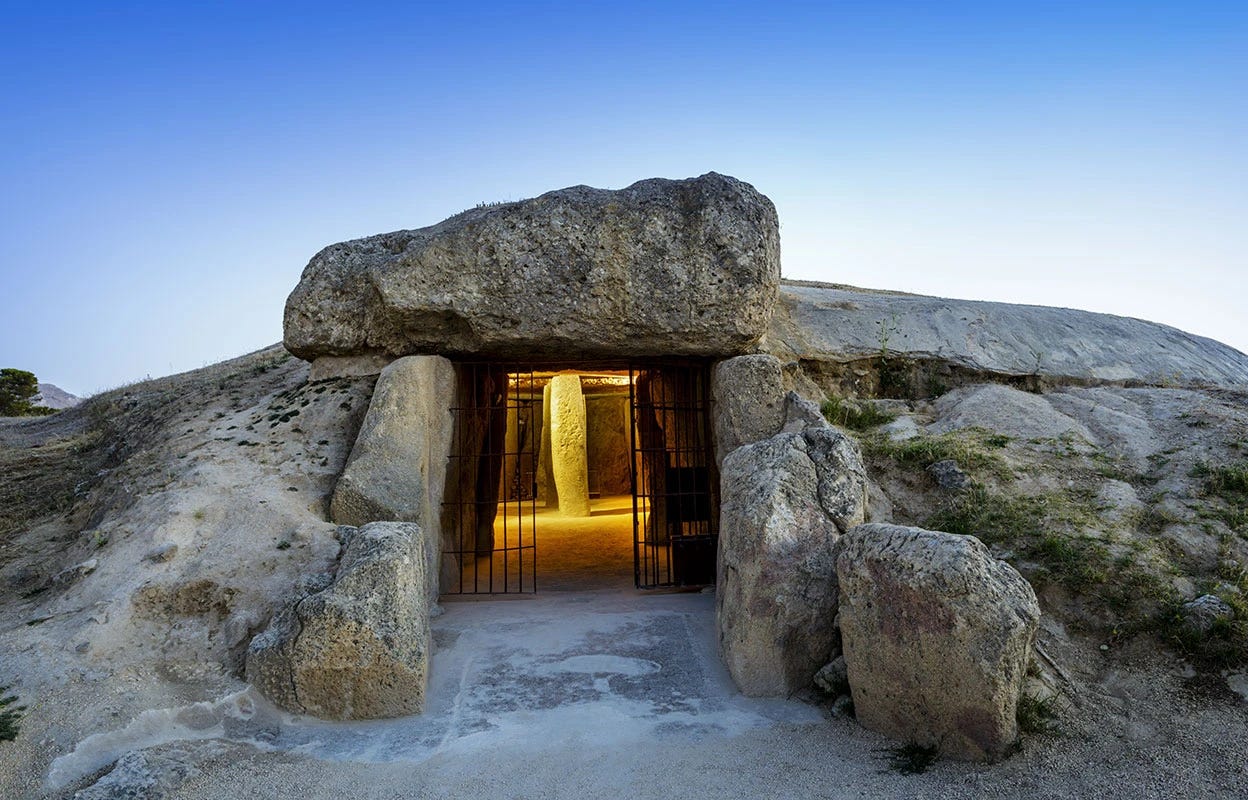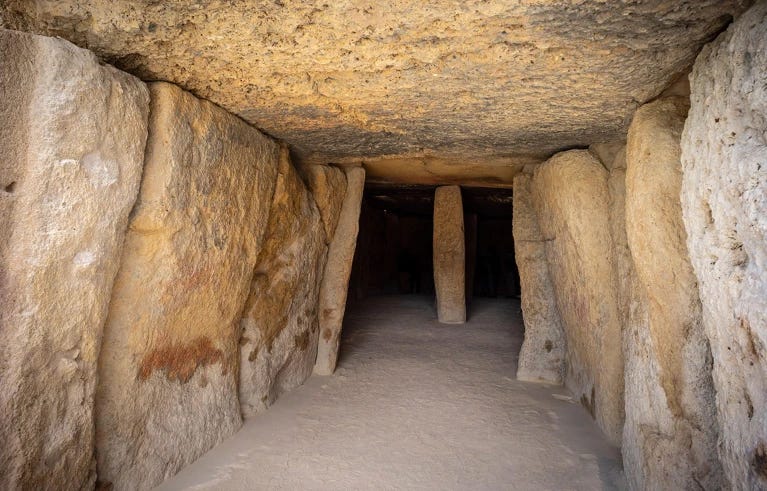Engineering Prowess of Neolithic Builders Revealed in 6,000-Year-Old Dolmen of Menga
Manage episode 436117217 series 3444207
A groundbreaking study of the Dolmen of Menga, a massive Neolithic stone monument located in southern Spain, has unveiled remarkable evidence of the advanced engineering and scientific understanding possessed by its builders nearly 6,000 years ago. This research, recently published1 in Science Advances, highlights the technological abilities of the early farmers and herders who constructed the dolmen, suggesting that they had a sophisticated grasp of physics, geometry, geology, and architecture long before the advent of written records.

By utilizing high-resolution laser scanning technology and analyzing previously unpublished photos and diagrams from earlier excavations, archaeologists have reconstructed the probable construction techniques used to create the Dolmen of Menga. Their findings indicate that the Neolithic builders employed intricate methods to move and position enormous stones with precision, showcasing an understanding of science that rivals that of later civilizations. Despite being built 1,000 years before Stonehenge, the engineering demands placed on the Dolmen of Menga's creators were comparable, if not more challenging. Leonardo García Sanjuán, an archaeologist at the University of Seville in Spain and a co-author of the study remarked,
“These people had no blueprints to work with, nor, as far as we know, any previous experience at building something like this. And yet, they understood how to fit together huge blocks of stone” with “a precision that would keep the monument intact for nearly 6,000 years.”
The Dolmen of Menga: An Architectural Marvel
The Dolmen of Menga is a massive stone chamber, measuring approximately 28 meters in length, 6 meters in width, and 3.5 meters in height. The monument was constructed using 32 enormous stone blocks that were transported from a quarry located about one kilometer away. These blocks formed the walls, pillars, and roof of the dolmen, with the largest capstone—a key component of the roof—measuring 8 meters in length and weighing an estimated 150 tonnes. In comparison, the heaviest stones used to build Stonehenge weigh about 30 tonnes, highlighting the immense challenge faced by the builders of Menga.
Transporting these enormous stones without breaking them was an engineering feat in itself, particularly given the use of soft sandstone for the roof. The researchers hypothesize that the Neolithic builders employed specially constructed wooden tracks to reduce friction as the stones were dragged from the quarry to the site. This method mirrors the techniques believed to have been used by the builders of Stonehenge to transport similarly large stones.
However, moving the stones was only part of the challenge. Once at the site, the builders had to precisely position the upright slabs into sockets carved 1.5 meters deep into the bedrock. The high-resolution laser scans revealed that this was accomplished through the use of counterweights and ramps, allowing the stones to be carefully tilted and placed at millimeter-scale angles. The stones were then carved into facets that allowed them to lock securely against their neighbors when the counterweights and ramps were removed. Michael Parker Pearson, an archaeologist at University College London said,
“The precision required to position these stones was extraordinary. With such big stones, they could not have afforded to make mistakes when maneuvering them into position. If even just one was a few centimeters out, it would have been incredibly difficult to correct once the stone was set in its trench.”
The Physics Behind a Super-Solid Structure
The builders of the Dolmen of Menga demonstrated a sophisticated understanding of the physics and geometry needed to ensure the structural integrity of their monument. The counterweight and ramp system allowed for fine adjustments during the construction process, ensuring that each stone was placed at the correct angle and locked securely in place. This attention to detail resulted in a "super-solid monument," according to Parker Pearson, comparable to the mortise-and-tenon joints used to connect the uprights and lintels at Stonehenge, albeit constructed 1,000 years earlier.
Despite being located in a seismically active region prone to earthquakes, the dolmen has remained structurally sound for nearly 6,000 years. This feat of ancient engineering is a testament to the builders’ knowledge of local geological conditions and their ability to create a structure that could withstand the forces of nature. García Sanjuán explained,
“Building in an earthquake-prone area would have required an even greater understanding of structural stability. The fact that the stonework remains snug and secure after all this time is a clear indication that these people really knew what they were doing.”
An Advanced Grasp of Science and Technology
The findings at the Dolmen of Menga not only highlight the engineering skills of Neolithic builders but also suggest that they had a practical understanding of scientific principles. The precision with which the stones were placed, the careful consideration of the monument’s location in relation to seismic activity, and the use of advanced construction techniques all point to a society with a working knowledge of physics, geometry, and geology. García Sanjuán said,
“There’s no way you could do that without at least a basic working knowledge of science.”
While these Neolithic builders may not have had formal education or written blueprints, their ability to construct such a massive and enduring monument speaks to a sophisticated understanding of the world around them.

The dolmen’s construction techniques also offer insights into the broader technological landscape of the time. The builders likely relied on a combination of observation, experimentation, and passed-down knowledge to achieve their goals, demonstrating that even in the absence of formal scientific methods, early societies could develop complex and effective solutions to engineering challenges.
Conclusion: Reassessing the Capabilities of Neolithic Societies
The study of the Dolmen of Menga has far-reaching implications for our understanding of Neolithic societies and their technological capabilities. The monument stands as a testament to the ingenuity, skill, and scientific knowledge of its builders, challenging the assumption that early human societies were less advanced in their understanding of the natural world.
This discovery not only deepens our understanding of the people who built the Dolmen of Menga but also provides a valuable reference point for comparing the technological achievements of other ancient civilizations, such as those that constructed Stonehenge. By continuing to study sites like Menga, archaeologists can uncover new insights into the development of science, technology, and engineering in early human history, helping to piece together the story of human evolution and cultural advancement.
In the words of Parker Pearson,
“The engineering skills demonstrated in the construction of the Dolmen of Menga are awe-inspiring. It is a reminder that ancient societies were capable of remarkable feats of architecture and design, even without the tools and technologies we take for granted today.”
Lozano Rodríguez, J. A., García Sanjuán, L., Jiménez-Espejo, F. J., Álvarez-Valero, A. M., Arrieta, J. M., Fraile-Nuez, E., García-Alix, A., Montero Artus, R., & Martínez-Sevilla, F. (2024). Early science and colossal stone engineering in Menga, a Neolithic dolmen (Antequera, Spain). Science Advances, 10(34). https://doi.org/10.1126/sciadv.adp1295
5 episodios




